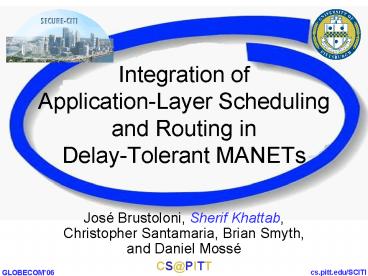Integration of ApplicationLayer Scheduling and Routing in DelayTolerant MANETs - PowerPoint PPT Presentation
1 / 33
Title:
Integration of ApplicationLayer Scheduling and Routing in DelayTolerant MANETs
Description:
Jos Brustoloni, Sherif Khattab, Christopher Santamaria, ... Pre-emption. 12. GLOBECOM'06. cs.pitt.edu/SCITI. Deadline. Work Order Model. Each task associated ... – PowerPoint PPT presentation
Number of Views:43
Avg rating:3.0/5.0
Title: Integration of ApplicationLayer Scheduling and Routing in DelayTolerant MANETs
1
Integration of Application-Layer Scheduling and
Routing in Delay-Tolerant MANETs
- José Brustoloni, Sherif Khattab, Christopher
Santamaria, Brian Smyth, and Daniel Mossé - CS_at_PITT
2
Mobile Ad-Hoc Networks (MANETs)
Cell phone
3
Mobile Ad-Hoc Networks (MANETs)
4
Communication of First-Responders
- Connecting handheld devices used to exchange
data, images, video, voice, work orders, etc.
5
Need for MANETs
- MANETs are
- needed if traditional
- communication
- infrastructure is
- damaged
6
Network Partitioning
- MANETs may get partitioned
- Field characteristics
- Noisy environments
Packethop.com
7
Delay-Tolerant Networking
- DTN research deals with routing of messages
across network partitions - Our work proposes a new approach to DTN routing
8
Example Scenario
Main Partition
Subordinate Partition
Leader
EOC
9
Example Scenario
Main Partition
Subordinate Partition
Work Order
Leader
EOC
10
Example Scenario
Main Partition
Subordinate Partition
Work Order
Courier
Leader
EOC
11
Work Order Model
Execution Time
Deadline
Pre-emption
Deadline Miss
Time
12
Work Order Model
Each task associated with a location
Deadline
13
Courier Selection Problem
Main Partition
Subordinate Partition
?
?
?
Work Order
Courier
Leader
EOC
14
Metrics
- Percentage of missed deadlines
- Average traveled distance per node
Number of deadlines missed
Total number of work orders
15
State-of-the-art
- Dedicated mobile elements
- Message Ferries _at_GeorgiaTech handle only
message delivery - Minimize average delay
- Trajectory modification of mobile users
- _at_Dartmouth Mobicom00
- Minimize detour distance
16
Our Hypothesis
- We can achieve better trade-off between missed
deadlines and traveled distance if
application-layer demand is taken into
consideration in courier selection
17
Highest-Slack Courier Selection
Main Partition
Subordinate Partition
Maximum Leeway
18
Compared Schemes
- Closest
- Select courier closest to work order destination
- Dedicated
- Set of nodes dedicated for message delivery
(dont execute any work) - Random
19
Common Assumption
- Leader aware of current position of
main-partition workers - GPS-enabled devices
- Landmarks
20
Simulation Parameters
- Rate of work orders (load)
- main and sub-ordinate
- default 60
- Distance between partitions
- default 1200m
- Number of dedicated couriers
- default 1
- Speed of dedicated couriers
- default 5 m/s (18 km/h)
21
Distance between Partitions
100
Dedicated
Random
Closest
Highest-Slack
80
60
Deadlines Missed
40
20
1200m
200m
400m
800m
22
Subordinate-partition Load
100
Random
Closest
Dedicated
Highest-Slack
80
60
Deadlines Missed
40
20
20
40
60
80
23
Why?
Main Partition
Subordinate Partition
24
Subordinate-partition Load
16km
12km
Random
Traveled Distance Per Node
8km
Closest
Highest-Slack
4km
Dedicated
20
40
60
80
25
Main-partition Load
100
Dedicated
Random
Closest
Highest-Slack
80
60
Deadlines Missed
40
20
20
40
60
80
26
Dedicated-courier Speed
100
Random
Closest
Dedicated
Highest-Slack
80
60
Deadlines Missed
40
20
54 km/h
18 km/h
25 km/h
27
Number of Dedicated Couriers
100
Random
Closest
Dedicated
Highest-Slack
80
60
Deadlines Missed
40
20
5
1
10
15
20
28
Conclusions and Future Work
- Courier Scheduling in partitioned ad-hoc networks
- Integrated application- and network-layer
scheduling - More realistic
- models of work orders
- metrics (e.g., rate of casualties)
- frequency and structure of network partitions
- Comparison with other schemes
- communication bridges
29
Questions ?
30
Work Order Parameters
- Average Deadline 440 sec
- Execution Time 0.5 Deadline
- Enough to run back and forth across a 500m
partition and still meet deadline
31
Simulation Time
Warm-up
Statistics Gathering
Cool-down
10000 ( 2.5 Hrs)
10
1000
9500
Time (Seconds)
32
When to return home?
Main Partition
Subordinate Partition
33
(No Transcript)































